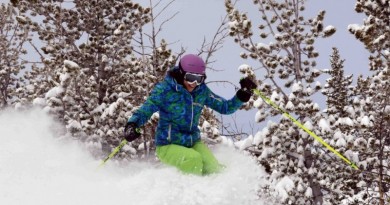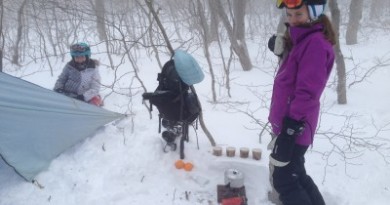In Defense of The Ski Lesson

Although many are turning away from lessons to cut costs, lessons for the novice skier of any age are important.
By Evan Johnson
An introduction to snow sports at any age is a thrilling experience and if done right, can mean the difference between a skier or rider just for the weekend and a skier or rider for life.
Kevin Harrington, director of the Mount Snow Ski School, knows exactly what that’s like.
“I’ve met people that say, ‘Yeah, I went skiing once,’ and I always say, ‘What do you mean once?’ So many first experiences are ruined by bad first experiences.”
The image of the hapless brand-new skier or rider is a fixture at almost every mountain. Stand at the bottom of the slope, look up the hill and you’ll be able to pick them out; the ones sporting gear purchased at a yard sale or hunched over their rental skis, knees together, twisting and contorting themselves as they struggle to link turn after turn at what seems like a painful, crawling pace.
What’s even sadder about these situations is more often than not the person has enlisted the help of a family member, friend or significant other to teach them. Will they want to continue skiing or riding after a first experience like this? Not often.
Any number of the things wrong with the above image could have easily been fixed with proper instruction and Vermont resorts have developed programs to assess and help everyone from novice to advanced get the most out of their winter sport of choice — be that skiing, riding or Nordic.
Lessons, of course, cost money, and as the cost of skiing rises, there is the temptation to cut costs.
But the untold story of ski and riding lessons is why they make economic sense and are, in every way, worth the money spent.
NOVICE SKIERS, NOVICE MISTAKES

For a novice, small initial mistakes can have an impact on their success of the lesson. Jeff Spring and Harley Johnson, Operations Director and Director at the Snow Sport University at Smugglers’ Notch, respectively, are quick to point out three mistakes people commonly make that keep them from having a best possible first experience.
“Sometimes it’s terrain,” says Johnson. “It’s the classic example of when the guy takes his girlfriend up Sterling lift (which accesses the most advanced terrain), thinking he’s going to teach her how to ski. Then it takes them two hours to get to the bottom and by the time they get down, their relationship is pretty strained.”
Other times, the error is in the equipment and preparation. Showing up wearing jeans and a cotton sweatshirt in subzero temperatures can only make for a miserable day on the hill. Outdated or improperly tuned equipment will likely prove an unnecessary obstacle when learning the basics, and is also unsafe.
Both skiing and riding emphasize using efficient movements to make turns to control speed. Using incorrect movements, results in what Spring describes as the “herky-jerk-ies,” where the skier or rider, unaware of how their body should properly move, does anything from wildly flailing arms to bizarre positions.
“If your back is sore after a day on the snow, you should probably be in a lesson,” he says.
A ski lesson ensures that the skier or rider is on terrain appropriate for their level and suitable for the skills the teacher is trying to develop. Instructors also commonly check students’ equipment and clothing to make sure they’re ready for the day in the snow.
“We have one coach that routinely sits down with his group right at the beginning and checks the students’ equipment – making sure they’re only wearing one pair of socks and that their ski pants aren’t tucked into the tops of their boots. Small things like this can have a big draw on the success of the students,” says Spring.
Importance of teachers
Harrington is quick to embrace the value of snow sports to families, but just as quick to issue a word of caution.
“Skiing is something you do for the rest of your life,” he says. “It’s multi-generational, something that you can really do together with your kids that they can continue to share… But don’t try to teach anyone you love or care about.”
It may sound callous, but as he explains, it means a world of difference in the experience of the students.
“As parents, we rush it because we always want to move faster than they do,” he explains. “When you learn from friends or family, the patience isn’t always there.”
Spring agrees. “With parents, [kids] have routines and expected behaviors and they come with those expectations a little more readily when the parent is the one teaching the lesson,” he says. “Those expectations can mean any number of things,” and many of them aren’t good for teaching a new sport like skiing or riding.
“There’s always an element of fear that comes with learning,” Spring says. “And that fear can manifest itself in different ways. They may not have fallen before in this kind of situation and some of the movements that we commonly make can be scary. The teacher’s job is to get the fear out [of the equation].”
An instructor often has more experience in helping students confront those anxieties and there is a different kind of a dynamic between teacher and student. Having someone unfamiliar be the teacher puts a student in a different mindset where they are more receptive to the material the teacher is providing.
Harrington uses his own daughter as an example.
At the age of three, she spent her first experiences on skis in the programs at Mount Snow Ski School, practicing moving in ski boots, getting used to the sensation of wearing and getting around in skis and easing her way down gentle slopes. Her introduction to the sport, he says, was done gradually by teachers who know the sport and how different kinds of students learn at different ages.
Now, at the age of four, when she rides up the lift with her dad and follows him the whole way down, people ask what his secret is.
“I tell them every time – ski lessons. It was nothing I did,” he says.
Smuggs’ Johnson says when she skis with her own kids, she doesn’t have to remind them to turn or to stay in control – they’ve learned proper technique and trail etiquette from their lessons.
Also, while the kids receive the help and instruction they need, parents can focus on their own skiing.
At Stratton Mountain, Ian Bruso has been working in the ski industry for nearly 20 years and meddling in the summertime frustration known as “golf” for the past four years. After taking golf lessons, Bruso says he began to see a difference in his game, and how much the old habits he created when he was “hacking away” still affected his performance.
Bruso says it’s the same way with learning to ski.
But if that sounds like too much of a sale, let’s do some math: A full-day ski lesson for a 7-14 year old at Mount Snow costs $99. This, plus the cost of a youth full-mountain lift ticket ($65) brings the total – before taxes or applicable discounts or offers – to $164 dollars.
But often, the price of a lift ticket is included in lesson prices. An adult lesson at Stratton, for example, costs $99 midweek and includes the cost of a lift ticket.
“Letting us be the teacher allows the family to have that family relationship,” Johnson says. “Parents can relax and develop their own skiing while their kids progress. If the family constantly has to buy day lift passes and works on the same skills every time, they may not see the progress they want.”
A lesson is a one-time purchase and when the student completes the lesson, they’ll have a number of things that they can work on and improve on their own time (instructors will tell them). The alternative is to continually buy lift tickets in order to work on the sport — often remaining at the same ability level for years.
Great Incentives
This year, a number of attractive packages have been developed at resorts throughout the state to bring in new skiers. Here are two examples:
Sugarbush’s First-Timer to Life-Timer Program includes a three-lesson series over three days, which includes lift tickets for all three days and equipment rental. The program, which comes with a free season pass for the remainder of the 2013-2014 winter season, costs $255. The resort has been offering this special deal for the past several years with great success and participation in the program continues to rise year after year.
“Our First-Timer to Life Timer Program is one of our more popular programs,” says Candice White, Vice President of Marketing and Communications at Sugarbush. “When a person is just starting in the sport, the stakes are extremely high. This program has been demonstrated to be popular with beginner skiers of all ages.”
White cites two testimonials that demonstrate the proficiency of the program.
“Paul” was a first time skier who started skiing with his new wife. He was 64, she was younger and neither had skied before. They signed up for the First-Timer-to-Life-Timer Program and wrote to chief executive of Sugarbush, Win Smith, after their stay, thanking the resort for the experience.
“I must tell you just how successful you have been in making me into a late blooming skier,” he wrote. “I simply have fallen in love with it…. I don’t know whether I like skiing because I’m picking it up pretty fast, or if I’m picking it up so well because I like it so much. Either way, I’m now a skier for life, and I believe that I have you and your program to thank….”
“Carter” was a 30 year old who decided to try snowboarding for the first time. He wrote to Smith and said the patient instruction of a teacher made a huge difference on his ability to improve.
“Your staff was just as excited as I was to be there, and even more so to see another person who was brand new wanting to learn the sport,” he wrote.
Meanwhile at Killington, the resort has launched a four-day adult Learn To Ski package this year. The package includes a two-hour lesson, rental equipment and lift ticket each of the four days. Upon completion, participants will receive a new pair of Killington Resort branded Elan eRise skis and bindings (MSRP $499) along with a discount voucher for new boots and poles. Participants also will receive 50 percent off all lift tickets and lessons for the remainder of the 2013-14 season and all of the 2014-15 season. The four lessons do not need to be consecutive and are valid any day during the 2013-14 winter season. The package costs $249.
In the long-term these programs are going to make sure you’re not only getting a good introduction to the sport, but you’re also more likely to stick with it.
“There’s more to skiing than just turning right and left,” says Stratton’s Ian Bruso. “The lesson gives you the opportunity to set up yourself for your first real experience with the sport. The goal isn’t just to develop your skills, it’s about developing the relationship with the sport that will endure for hopefully as long as possible.”


